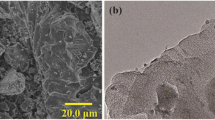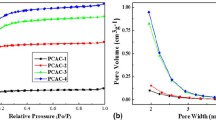Abstract
With increasing output of petroleum coke, the value-added exploitation of petroleum coke has become a tough problem. Preparing porous carbons is a traditional way to the value-added exploitation of petroleum coke. Here, we used a facile and efficient hard-templating strategy to synthesize mesoporous carbon with high surface area from petroleum coke. N2 adsorption analyses show that the BET specific area and pore volume of the carbons can reach up to 864 m2/g and 1.37 cm3/g, respectively. To utilize the abundant mesopores of the carbons, anthraquinone-modified mesoporous carbon was tested as an electrode material for supercapacitor applications. Electrochemical measurements demonstrated that the specific capacitance reached up to 366 F/g at the current density of 1 A/g, indicating a promising prospect of using this carbon in electrochemical energy-storage field. More importantly, the strategy used in this work can be easily modified to prepare other nano-carbon materials from petroleum coke.







Similar content being viewed by others
References
H. Al-Haj-Ibrahim and B.I. Morsi: Desulfurization of petroleum coke: A review. Ind. Eng. Chem. Res. 31(8), 1835 (1992).
N. Rambabu, R. Azargohar, A.K. Dalai, and J. Adjaye: Evaluation and comparison of enrichment efficiency of physical/chemical activations and functionalized activated carbons derived from fluid petroleum coke for environmental applications. Fuel Process. Technol. 106(2), 501 (2013).
T. Kawano, M. Kubota, M.S. Onyango, F. Watanabe, and H. Matsuda: Preparation of activated carbon from petroleum coke by KOH chemical activation for adsorption heat pump. Appl. Therm. Eng. 28(8), 865 (2008).
M. Kubota, T. Ito, F. Watanabe, and H. Matsuda: Pore structure and water adsorptivity of petroleum coke-derived activated carbon for adsorption heat pump—Influence of hydrogen content of coke. Appl. Therm. Eng. 31(8), 1495 (2011).
X. Li, Q. Zhang, L. Tang, P. Lu, F. Sun, and L. Li: Catalytic ozonation of p-chlorobenzoic acid by activated carbon and nickel supported activated carbon prepared from petroleum coke. J. Hazard. Mater. 163(1), 115 (2009).
C. Lu, S. Xu, and C. Liu: The role of K2CO3 during the chemical activation of petroleum coke with KOH. J. Anal. Appl. Pyrolysis 87(2), 282 (2010).
C. Peng, Z. Wen, Y. Qin, S.M. Lukas, C. Li, S. Yang, D. Shi, and J. Yang: Three-dimensional graphitized carbon nano vesicles for high-performance supercapacitors based on ionic liquids. ChemSusChem 7(3), 777 (2014).
M. Sánchez-Polo and J. Rivera-Utrilla: Ozonation of naphthalenetrisulphonic acid in the presence of activated carbons prepared from petroleum coke. Appl. Catal., B 67(1–2), 113 (2006).
R. Xiao, S. Xu, Q. Li, and Y. Su: The effects of hydrogen on KOH activation of petroleum coke. J. Anal. Appl. Pyrolysis 96(12), 120 (2012).
M. Yuan, S. Tong, S. Zhao, and C.Q. Jia: Adsorption of polycyclic aromatic hydrocarbons from water using petroleum coke-derived porous carbon. J. Hazard. Mater. 181(1–3), 1115 (2010).
H. Zhang, Y. Jiang, Y. Hu, A. Maclennan, W. Hui, and C. Wang: Effect of pyrite in precursor on capacitance behavior of prepared activated carbon. Ind. Eng. Chem. Res. 53(24), 10125 (2014).
P. Zhang, X.H. Liu, K.X. Li, and Y.R. Lu: Heteroatom-doped highly porous carbon derived from petroleum coke as efficient cathode catalyst for microbial fuel cells. Int. J. Hydrogen Energy 40(39), 13530 (2015).
W. Qiao, S.H. Yoon, and I. Mochida: KOH activation of needle coke to develop activated carbons for high-performance EDLC. Energy Fuels 20(4), 1680 (2006).
X. Wei and Y.Z. Feng: Effects of preoxidation on the surface properties of super active carbon. New Carbon Mater. 17(3), 25 (2002).
C. Lu, S. Xu, Y. Gan, S. Liu, and C. Liu: Effect of pre-carbonization of petroleum cokes on chemical activation process with KOH. Carbon 43(11), 2295 (2005).
B. Jiang, Y. Zhang, J. Zhou, K. Zhang, and S. Chen: Effects of chemical modification of petroleum cokes on the properties of the resulting activated carbon. Fuel 87(10–11), 1844 (2008).
D. Tateishi, K. Esumi, and H. Honda: Formation of carbonaceous gel. Carbon 29(8), 1296 (1991).
D. Tateishi, K. Esumi, H. Honda, and H. Oda: Preparation of carbonaceous gel beads. Carbon 30(6), 942 (1992).
K. Esumi, S. Eshima, Y. Murakami, H. Honda, and H. Oda: Preparation of hollow carbon-microbeads from water-in-oil emulsion using amphiphilic carbonaceous material. Colloids Surf., A 108(1), 113 (1996).
Z. Li, W. Yan, and S. Dai: A novel vesicular carbon synthesized using amphiphilic carbonaceous material and micelle templating approach. Carbon 42(4), 767 (2004).
H. Oda, D. Tateishi, K. Esumi, and H. Honda: The formation of porous carbon materials from carbonaceous gel. Carbon 32(2), 355 (1994).
J. Wang, M. Chen, C. Wang, J. Wang, and J. Zheng: Preparation of mesoporous carbons from amphiphilic carbonaceous material for high-performance electric double-layer capacitors. J. Power Sources 196(1), 550 (2011).
J. Wang, M. Chen, C. Wang, J. Wang, and J. Zheng: A facile method to prepare carbon aerogels from amphiphilic carbon material. Mater. Lett. 68(1), 446 (2012).
Y. Yuan, C. Zhang, C. Wang, and M. Chen: Amphiphilic carbonaceous material-based hierarchical porous carbon aerogels for supercapacitors. J. Solid State Electrochem. 19(2), 619 (2014).
S. Han and T. Hyeon: Simple silica-particle template synthesis of mesoporous carbons. Chem. Commun. 19(19), 1955 (1999).
S. Li, T. Chungui, F. Yu, Y. Ying, Y. Jie, W. Lei, and F. Honggang: Nitrogen-doped porous graphitic carbon as an excellent electrode material for advanced supercapacitors. Chem.–Eur. J. 20(2), 564 (2014).
A. Olejniczak, M. Lezanska, J. Wloch, A. Kucinska, and J.P. Lukaszewicz: Novel nitrogen-containing mesoporous carbons prepared from chitosan. J. Mater. Chem. A 1(31), 8961 (2013).
H. Wang, H. Yi, C. Zhu, X. Wang, and H.J. Fan: Functionalized highly porous graphitic carbon fibers for high-rate supercapacitive electrodes. Nano Energy 13, 658 (2015).
H-L. Wang, Z-Q. Shi, J. Jin, C-B. Chong, and C-Y. Wang: Properties and sodium insertion behavior of phenolic resin-based hard carbon microspheres obtained by a hydrothermal method. J. Electroanal. Chem. 755, 87 (2015).
H.A. Le, T.L. Le, S. Chin, and J. Jurng: Photocatalytic degradation of methylene blue by a combination of TiO2-anatase and coconut shell activated carbon. Powder Technol. 225(7), 167 (2012).
L.X. Jin, X. Wei, Z. Jin, W.G. Qiang, Z.S. Ping, Y.Z. Feng, X.Q. Zhong, and Q.S. Zhang: Excellent capacitive performance of a three-dimensional hierarchical porous graphene/carbon composite with a superhigh surface area. Chem.–Eur. J. 20(41), 13314 (2014).
R. Kumar, V. More, S.P. Mohanty, S.S. Nemala, S. Mallick, and P. Bhargava: A simple route to making counter electrode for dye sensitized solar cells (DSSCs) using sucrose as carbon precursor. J. Colloid Interface Sci. 459, 146 (2015).
R. Qiang, Z. Hu, Y. Yang, Z. Li, N. An, X. Ren, H. Hu, and H. Wu: Monodisperse carbon microspheres derived from potato starch for asymmetric supercapacitors. Electrochim. Acta 167, 303 (2015).
Z. Li, W. Lv, C. Zhang, B. Li, F. Kang, and Q-H. Yang: A sheet-like porous carbon for high-rate supercapacitors produced by the carbonization of an eggplant. Carbon 92, 11 (2015).
W. Huanlei, X. Zhanwei, K. Alireza, L. Zhi, C. Kai, T. Xuehai, S. Tyler James, C.K. King’Ondu, C.M.B. Holt, and B.C. Olsen: Interconnected carbon nanosheets derived from hemp for ultrafast supercapacitors with high energy. ACS Nano 7(6), 5131 (2013).
J. Huang, J. Wang, C. Wang, H. Zhang, C. Lu, and J. Wang: Hierarchical porous graphene carbon-based supercapacitors. Chem. Mater. 27, 2107 (2015).
X. Li and B. Wei: Supercapacitors based on nanostructured carbon. Nano Energy 2(2), 159 (2012).
F. Béguin, V. Presser, A. Balducci, and E. Frackowiak: Carbons and electrolytes for advanced supercapacitors. Adv. Mater. 26(14), 2219 (2014).
G. Xiong, C. Meng, R.G. Reifenberger, P.P. Irazoqui, and T.S. Fisher: A review of graphene-based electrochemical microsupercapacitors. Electroanalysis 26(1), 30 (2014).
M. Vangari, T. Pryor, and J. Li: Supercapacitors: Review of materials and fabrication methods. J. Energy Eng. 139(2), 72 (2013).
S. He and W. Chen: High performance supercapacitors based on three-dimensional ultralight flexible manganese oxide nanosheets/carbon foam composites. J. Power Sources 262, 391 (2014).
M.L. Huang, C.D. Gu, X. Ge, X.L. Wang, and J.P. Tu: NiO nanoflakes grown on porous graphene frameworks as advanced electrochemical pseudocapacitor materials. J. Power Sources 259, 98 (2014).
M. Sawangphruk, P. Srimuk, P. Chiochan, A. Krittayavathananon, S. Luanwuthi, and J. Limtrakul: High-performance supercapacitor of manganese oxide/reduced graphene oxide nanocomposite coated on flexible carbon fiber paper. Carbon 60, 109 (2013).
Z. Niu, P. Luan, Q. Shao, H. Dong, J. Li, J. Chen, D. Zhao, L. Cai, W. Zhou, X. Chen, and S. Xie: A “skeleton/skin” strategy for preparing ultrathin free-standing single-walled carbon nanotube/polyaniline films for high performance supercapacitor electrodes. Energy Environ. Sci. 5(9), 8726 (2012).
Y. Song, J-L. Xu, and X-X. Liu: Electrochemical anchoring of dual doping polypyrrole on graphene sheets partially exfoliated from graphite foil for high-performance supercapacitor electrode. J. Power Sources 249, 48 (2014).
Y. Xu, Z. Lin, X. Huang, W. Yang, H. Yu, and X. Duan: Functionalized graphene hydrogel-based high-performance supercapacitors. Adv. Mater. 25(40), 5779 (2013).
N. An, F. Zhang, Z. Hu, Z. Li, L. Li, Y. Yang, B. Guo, and Z. Lei: Non-covalently functionalizing a graphene framework by anthraquinone for high-rate electrochemical energy storage. RSC Adv. 5, 23942 (2015).
X. Chen, H. Wang, H. Yi, X. Wang, X. Yan, and Z. Guo: Anthraquinone on porous carbon nanotubes with improved supercapacitor performance. J. Phys. Chem. C 118(16), 8262 (2014).
Q. May, S. Daniel, M.F. Wasylkiw, and D.K. Smith: Voltammetry of quinones in unbuffered aqueous solution: Reassessing the roles of proton transfer and hydrogen bonding in the aqueous electrochemistry of quinones. J. Am. Chem. Soc. 129(42), 12847 (2007).
X. Wu, W. Xing, J. Florek, J. Zhou, G. Wang, S. Zhuo, Q. Xue, Z. Yan, and F. Kleitz: On the origin of the high capacitance of carbon derived from seaweed with an apparently low surface area. J. Mater. Chem. A 2, 18998 (2014).
X. Wu, J. Zhou, W. Xing, Y. Zhang, P. Bai, B. Xu, S. Zhuo, Q. Xue, and Z. Yan: Insight into high areal capacitances of low apparent surface area carbons derived from nitrogen-rich polymers. Carbon 94, 560 (2015).
ACKNOWLEDGMENTS
This work was financially supported by National Natural Science Foundation of China (21476264), Distinguished Young Scientist Foundation of Shandong Province (JQ201215), Taishan Scholar Foundation (ts20130929) and Fundamental Research Funds for the Central Universities (15CX05029A, 15CX08009A), Graduate Student Innovation Project of China University of Petroleum (East China) (YCXJ2016082).
Author information
Authors and Affiliations
Corresponding author
Supplementary Material
43578_2017_32071248_MOESM1_ESM.docx
Supporting Information: Functionalization of petroleum coke-based mesoporous carbon for synergistically enhanced capacitive performance (approximately 18.3 KB)
Rights and permissions
About this article
Cite this article
Huang, J., Xing, W., Subhan, F. et al. Functionalization of petroleum coke-based mesoporous carbon for synergistically enhanced capacitive performance. Journal of Materials Research 32, 1248–1257 (2017). https://doi.org/10.1557/jmr.2017.36
Received:
Accepted:
Published:
Issue Date:
DOI: https://doi.org/10.1557/jmr.2017.36




